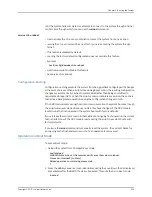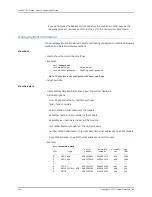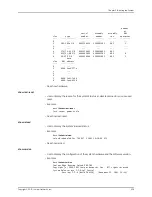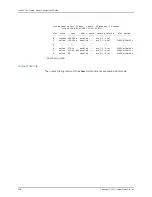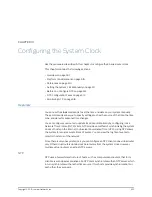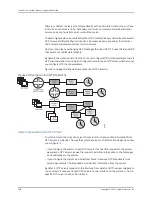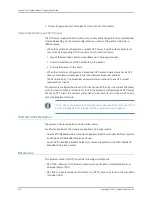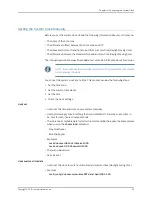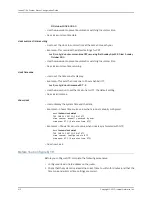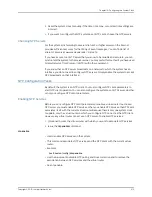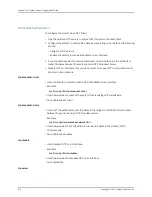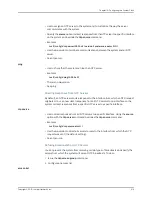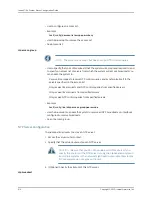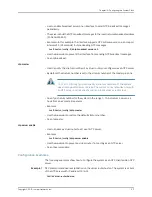
until the command is completed, or attempt to connect to the system through a Telnet
or SSH client through which you can use the
reload
command.
service ctrl-x-reboot
•
Use to enable the Ctrl+x key combination to reset the system from any location.
•
Issuing the Ctrl+x command has no effect if you are accessing the system through
Telnet.
•
This feature is disabled by default.
•
Loading the factory default configuration does not override this feature.
•
Example
host1(config)#
service ctrl-x-reboot
•
Use the
no
version to disable this feature.
•
See service ctrl-x-reboot.
Configuration Caching
Configuration caching prevents the system from being partially configured with changes
in the event of a reset. When a script or macro begins execution, the resulting configuration
changes are automatically cached in system RAM rather than being committed to
nonvolatile storage (NVS). When the script or macro completes execution, the cache is
flushed as a background operation, saving the configuration changes to NVS.
If the SRP module resets during the script or macro execution, the system boots as though
the script were never started because no NVS files have changed. If the SRP module
resets during the flush operation, the system boots with factory defaults.
If you start another script or macro in the middle of an ongoing flush operation, the current
flush is halted; now if the SRP module resets during the script, the system boots with
factory defaults.
If you issue the
reload
command to manually reset the system, the system checks for
an ongoing cache flush and warns you if a flush operation is discovered.
Operations in Boot Mode
To access Boot mode:
1.
Reload the system from Privileged Exec mode:
host1#
reload
WARNING: Execution of this command will cause the system to reboot.
Proceed with reload? [confirm]
Reload operation commencing, please wait...
7
2.
Press the
mb
key sequence (case-insensitive) during the countdown that is displayed
immediately after the BPOST tests are bypassed. This puts the CLI in Boot mode.
:boot##
503
Copyright © 2010, Juniper Networks, Inc.
Chapter 9: Booting the System
Summary of Contents for JUNOSE 11.3
Page 6: ...Copyright 2010 Juniper Networks Inc vi...
Page 8: ...Copyright 2010 Juniper Networks Inc viii JunosE 11 3 x System Basics Configuration Guide...
Page 24: ...Copyright 2010 Juniper Networks Inc xxiv JunosE 11 3 x System Basics Configuration Guide...
Page 32: ...Copyright 2010 Juniper Networks Inc 2 JunosE 11 3 x System Basics Configuration Guide...
Page 146: ...Copyright 2010 Juniper Networks Inc 116 JunosE 11 3 x System Basics Configuration Guide...
Page 166: ...Copyright 2010 Juniper Networks Inc 136 JunosE 11 3 x System Basics Configuration Guide...
Page 432: ...Copyright 2010 Juniper Networks Inc 402 JunosE 11 3 x System Basics Configuration Guide...
Page 488: ...Copyright 2010 Juniper Networks Inc 458 JunosE 11 3 x System Basics Configuration Guide...
Page 524: ...Copyright 2010 Juniper Networks Inc 494 JunosE 11 3 x System Basics Configuration Guide...
Page 554: ...Copyright 2010 Juniper Networks Inc 524 JunosE 11 3 x System Basics Configuration Guide...
Page 566: ...Copyright 2010 Juniper Networks Inc 536 JunosE 11 3 x System Basics Configuration Guide...
Page 588: ...Copyright 2010 Juniper Networks Inc 558 JunosE 11 3 x System Basics Configuration Guide...
Page 613: ...PART 3 Index Index on page 585 583 Copyright 2010 Juniper Networks Inc...
Page 614: ...Copyright 2010 Juniper Networks Inc 584 JunosE 11 3 x System Basics Configuration Guide...
Page 632: ...Copyright 2010 Juniper Networks Inc 602 JunosE 11 3 x System Basics Configuration Guide...















